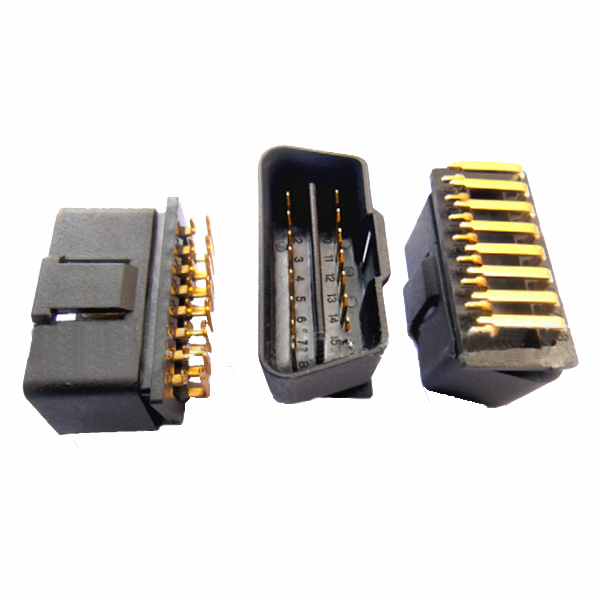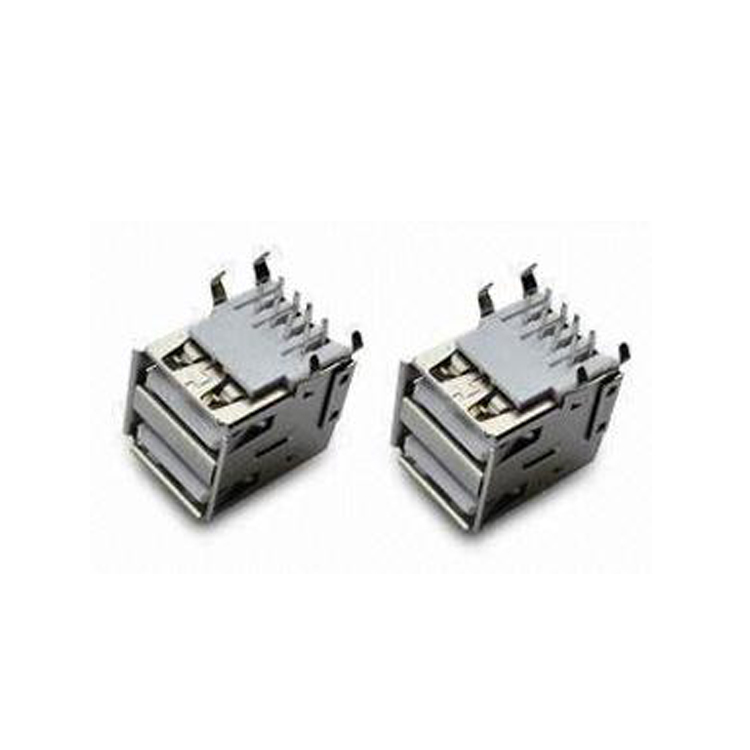Overall, 2.0mm Hard Metric Connectors offer a compact and reliable solution for board-to-board connections in applications where space is limited. Their small size, high-density packaging, and moderate to high current and voltage ratings make them suitable for a wide range of industries, including telecommunications, industrial automation, computer systems, and consumer electronics. By carefully considering the size, current, and voltage rating, as well as other features, engineers can choose the appropriate 2.0mm Hard Metric Connector for their specific application, ensuring a reliable and efficient connection between circuit boards.
Yes, there are different socket types available for 2.0mm Hard Metric Connectors. These socket types offer flexibility and versatility in board-to-board connections, allowing engineers to choose the most suitable option for their specific application requirements.
One common type of socket used in 2.0mm Hard Metric Connectors is the straight socket. This type of socket has pins that are oriented perpendicular to the circuit board, providing a direct connection between two boards in a straight line. Straight sockets are ideal for applications where a simple and straightforward board-to-board connection is needed.
Another type of socket is the right-angle socket. This type of socket has pins that are oriented at a right angle to the circuit board. Right-angle sockets are often used when boards need to be connected at a 90-degree angle or when space constraints require a compact and space-saving design. This allows for more flexibility in board placement and routing.
Furthermore, there are also surface mount sockets available for 2.0mm Hard Metric Connectors. Surface mount sockets are designed to be mounted directly on the surface of the circuit board, eliminating the need for through-hole soldering. They provide a more convenient and efficient solution for high-density board-to-board connections, as they can be easily placed and soldered using automated assembly processes.
Additionally, hybrid sockets are available, which combine the features of both straight and right-angle sockets. Hybrid sockets provide greater flexibility in board placement and orientation, allowing for connections at different angles and orientations within the same connector system.
It is important to consider the specific application requirements, including board layout and space constraints, when selecting the appropriate socket type for 2.0mm Hard Metric Connectors. Engineers should also consider factors such as the number of pins required, mating force, and the overall durability and reliability of the connector system.
In conclusion, 2.0mm Hard Metric Connectors offer a range of socket types to choose from, including straight sockets, right-angle sockets, surface mount sockets, and hybrid sockets. These socket types provide flexibility and versatility in board-to-board connections, allowing engineers to select the most suitable option for their specific application needs.
3.Main purposes and application areas 2.0mm Hard Metric Connectors are widely used in various industries and applications due to their versatility and reliability. These connectors offer a reliable and efficient solution for board-to-board and wire-to-board connections.
One of the main purposes of 2.0mm Hard Metric Connectors is to provide a connection interface between printed circuit boards (PCBs). They allow for the secure and stable transfer of signals, power, and data between different boards in electronic devices. These connectors are commonly used in applications such as telecommunications equipment, computer systems, industrial automation, medical devices, and automotive electronics.
In the telecommunications industry, 2.0mm Hard Metric Connectors are used in networking and communication equipment, including routers, switches, and servers. These connectors provide high-speed transmission of signals and data, ensuring reliable and efficient communication.
In computer systems, 2.0mm Hard Metric Connectors are utilized in motherboards, expansion cards, and peripheral devices. They enable the connection between different components, such as processors, memory modules, graphics cards, and storage devices. These connectors ensure the smooth operation and data transfer within the computer system.
Industrial automation is another key area where 2.0mm Hard Metric Connectors find extensive use. They are employed in control systems, PLCs (Programmable Logic Controllers), and industrial machinery. These connectors provide a reliable and secure connection between various sensors, actuators, and control modules, ensuring the efficient operation of the automated systems.
In the medical field, 2.0mm Hard Metric Connectors are utilized in medical devices and equipment. They are commonly found in patient monitoring systems, diagnostic equipment, and medical imaging devices. These connectors enable the transfer of signals and data, allowing for accurate monitoring and diagnosis of patients.
Automotive electronics also rely on 2.0mm Hard Metric Connectors for their electrical and electronic systems. These connectors are used in applications such as infotainment systems, engine control units, lighting systems, and advanced driver-assistance systems (ADAS). They provide a reliable and robust connection, ensuring the safe and efficient operation of the vehicle's electronic systems.
Overall, 2.0mm Hard Metric Connectors play a crucial role in various industries and applications. With their durability, reliability, and versatility, these connectors provide a reliable and efficient solution for board-to-board and wire-to-board connections, enabling the seamless transfer of signals, power, and data in electronic devices and systems.
4. How durable and reliable is it? 2.0mm Hard Metric Connectors are highly regarded for their durability and reliability. These connectors are designed to withstand demanding operating conditions and provide a long-lasting and stable connection between circuit boards.
The durability of 2.0mm Hard Metric Connectors can be attributed to a combination of factors. Firstly, they are constructed using high-quality materials such as high-temperature thermoplastics and metal alloys. These materials offer excellent mechanical strength and resistance to wear and tear, ensuring that the connectors can withstand the rigors of daily use. Additionally, the pins and contacts of these connectors are often gold-plated, enhancing their durability by providing corrosion resistance and ensuring reliable electrical conductivity.
Moreover, 2.0mm Hard Metric Connectors are specifically engineered to withstand high levels of vibration and shock. They feature robust locking mechanisms such as latches or screws that keep the connectors securely in place, preventing accidental disconnections. This ensures a stable and reliable connection even in demanding environments where vibrations and shocks are common, such as in automotive or industrial applications.
In addition to their physical durability, 2.0mm Hard Metric Connectors are designed to provide reliable electrical performance. The contact design and materials used in these connectors minimize contact resistance, ensuring a low insertion force and reliable electrical connection. The connectors are often rated for high current and voltage levels, allowing them to handle demanding power requirements.
To ensure the reliability of 2.0mm Hard Metric Connectors, they undergo rigorous testing and quality control processes during manufacturing. These connectors are tested for factors such as mechanical strength, electrical performance, and temperature resistance. Compliance with industry standards and certifications further ensures their reliability.
It is important to note that the overall durability and reliability of 2.0mm Hard Metric Connectors can also depend on factors such as proper installation, maintenance, and the quality of the mating connectors. Following manufacturer guidelines and using compatible connectors will help ensure optimal performance and longevity.
In summary, 2.0mm Hard Metric Connectors are highly durable and reliable. Their robust construction, secure locking mechanisms, and high-quality materials contribute to their ability to withstand harsh environments and provide a stable and long-lasting connection. These connectors are trusted in various industries where reliability and durability are critical, such as telecommunications, industrial automation, and automotive applications.
2.0mm Hard Metric Connectors are designed to provide a reliable and efficient connection between circuit boards. They consist of male and female connector components that are specifically designed to interlock and create a secure electrical connection.
The working principle of 2.0mm Hard Metric Connectors is relatively straightforward. The male connector, also known as the
Pin Header, is mounted onto one circuit board, while the female connector, also known as the receptacle, is mounted on the other circuit board. The male pins of the pin header are aligned with the corresponding female sockets of the receptacle.
To establish a connection, the two boards are brought together, aligning the male and female connectors. Once aligned, the male pins are inserted into the female sockets, creating a complete electrical connection. The pins and sockets are designed to have a tight fit, ensuring a secure and stable connection.
The pins of the male connector are typically made of conductive materials such as copper or brass, while the sockets of the female connector are made of a conductive material such as phosphor bronze. In some cases, the pins and sockets may be gold-plated to enhance conductivity and prevent corrosion.
2.0mm Hard Metric Connectors often feature a locking mechanism to ensure that the connection remains secure. This can be in the form of a latch, screw, or other locking mechanism. Once the connectors are fully inserted and locked, they will remain securely connected until intentionally disconnected.
These connectors are designed to handle high-speed data transmission, high power, and high-frequency signals. They provide a reliable and stable connection, minimizing signal loss and interference.
The modular design of 2.0mm Hard Metric Connectors allows for easy installation and removal, making them suitable for applications where frequent board-to-board connections are required. They are also designed to withstand various environmental conditions, such as temperature fluctuations, vibrations, and shocks, ensuring reliable performance in demanding applications.
In summary, 2.0mm Hard Metric Connectors work by interlocking male and female connector components to establish a secure and stable electrical connection between circuit boards. Their modular design, durability, and reliability make them a popular choice for a wide range of applications in industries such as telecommunications, industrial automation, and automotive electronics.
6. How to install and use? Installing and using 2.0mm Hard Metric Connectors is a relatively straightforward process. Here is a step-by-step guide on how to install and use these connectors:
Prepare the circuit boards: Ensure that the circuit boards you intend to connect are clean and free from any dust, debris, or contaminants. This will help ensure a reliable and secure connection.
Position the male and female connectors: Identify the male and female connectors on the respective circuit boards. The male connector, also known as the pin header, is usually mounted on one circuit board, while the female connector, known as the receptacle, is mounted on the other circuit board.
Align the connectors: Carefully align the male and female connectors so that the pins of the male connector are in line with the corresponding sockets of the female connector. Take caution to align them properly to avoid any damage to the pins or sockets.
Insert the pins into the sockets: Once the connectors are aligned, gently insert the pins of the male connector into the sockets of the female connector. Apply even pressure to ensure a smooth insertion. Make sure that the pins are fully inserted into the sockets for a secure connection.
Lock the connectors: If your 2.0mm Hard Metric Connectors have a locking mechanism, such as a latch or a screw, activate it to secure the connection. This will prevent any accidental disconnections caused by vibrations or movement.
Test the connection: Once the connectors are installed and locked, it is essential to test the connection to ensure it is secure and functional. Use appropriate testing equipment or procedures to verify that the signals, power, or data are being transmitted accurately between the connected circuit boards.
Proper handling and maintenance: To ensure the optimal performance and longevity of the connectors, handle them with care and avoid applying excessive force or pressure. Regularly inspect the connectors for any signs of damage or wear and clean them if necessary. Follow the manufacturer's guidelines for proper maintenance and handling.
Remember that proper installation and usage of 2.0mm Hard Metric Connectors are crucial to maintaining a reliable and secure connection. Following the steps outlined above and adhering to manufacturer guidelines will help ensure the connectors' optimal performance and longevity.
In summary, installing and using 2.0mm Hard Metric Connectors involves aligning the male and female connectors, inserting the pins into the sockets, locking the connectors if applicable, testing the connection, and practicing proper handling and maintenance. These connectors provide a reliable and efficient solution for board-to-board and wire-to-board connections in various industries and applications.


